| dc.contributor.advisor | Michael Short. | en_US |
| dc.contributor.author | Skowronski, Natasha (Natasha C.) | en_US |
| dc.contributor.other | Massachusetts Institute of Technology. Department of Nuclear Science and Engineering. | en_US |
| dc.date.accessioned | 2018-05-17T19:07:08Z | |
| dc.date.available | 2018-05-17T19:07:08Z | |
| dc.date.copyright | 2017 | en_US |
| dc.date.issued | 2017 | en_US |
| dc.identifier.uri | http://hdl.handle.net/1721.1/115454 | |
| dc.description | Thesis: S.B., Massachusetts Institute of Technology, Department of Nuclear Science and Engineering, 2017. | en_US |
| dc.description | DISCLAIMER NOTICE: The pagination in this thesis reflects how it was delivered to the Institute Archives and Special Collections. Cataloged from student-submitted PDF version of thesis. | en_US |
| dc.description | Includes bibliographical references (pages 46-48). | en_US |
| dc.description.abstract | The mechanism by which tellurium causes intergranular corrosion (IGC) of structural alloys in molten salt reactors is currently poorly understood. Limited corrosion testing has been performed on a few select alloys in simulated reactor conditions. In this thesis, the results of performing 50 h, 100 h, and 150 h corrosion tests on alloys Hastelloy N, Nickel-201, Incoloy 8ooH, and 316L Stainless Steel are presented. Upon inspection of the corroded surfaces of each alloy after its immersion in molten LiF-NaF-KF (FLiNaK) salt at 700 °C using scanning electron microscopy (SEM) and energy-dispersive x-ray spectroscopy (EDS), a consistent corrosion rate could not be determined for any of the alloys, nor could confident identification of telluride compounds within the corrosion layer or grain boundaries of any alloy be made. However, the results did appear to confirm the importance of using a low oxygen environment and avoidance of galvanic corrosion during testing. Furthermore, preliminary results from EDS analysis of one alloy sample implied that, with improved count rates taken during the elemental identification process, tellurium may be more clearly revealed in the corrosion layers and grain boundaries of the alloys tested. | en_US |
| dc.description.statementofresponsibility | by Natasha Skowronski. | en_US |
| dc.format.extent | 78 pages | en_US |
| dc.language.iso | eng | en_US |
| dc.publisher | Massachusetts Institute of Technology | en_US |
| dc.rights | MIT theses are protected by copyright. They may be viewed, downloaded, or printed from this source but further reproduction or distribution in any format is prohibited without written permission. | en_US |
| dc.rights.uri | http://dspace.mit.edu/handle/1721.1/7582 | en_US |
| dc.subject | Nuclear Science and Engineering. | en_US |
| dc.title | Telluridm-induced corrosion of structural alloys for nuclear applications in molten salts | en_US |
| dc.type | Thesis | en_US |
| dc.description.degree | S.B. | en_US |
| dc.contributor.department | Massachusetts Institute of Technology. Department of Nuclear Science and Engineering | |
| dc.identifier.oclc | 1035390216 | en_US |
